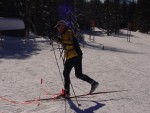Pacheco State Park
Date: Nov. 15 - 16, 2014
Location: Hollister, CA
Event Director: - 510.681.6181
Course Setters: Virginia DeBons, Dennis Wilkinson
Type: B; 2-day event with Classic courses on Saturday and a mini Rogaine on Sunday
Course Setters' Notes
By Rex Winterbottom and Dennis Wilkinson
Saturday 7-Course Information
Remote Start: There’s an approximately 1 km walk to the Start.
Courses: I’ve looked at the most recent Condes file, and the courses are standard length for beginner-intermediate (White, Yellow, Orange) and Middle length for advanced (Brown, Green, Red, and Blue). The Blue course tops out at 4.8 km, and Brown should actually be the appropriate standard length.
Here are the details of the courses:
Course Length Climb Controls White 2.2 km 40 m 8 Yellow 3.0 km 65 m 11 Orange 2.7 km 80 m 9 Brown 2.8 km 145 m 11 Green 3.9 km 205 m 16 Red 4.2 km 215 m 17 Blue 4.6 km 225 m 24
Beginners should be aware that the course lengths are the cumulative straight-line distances between controls. Your actual distance will be somewhat longer, depending on route choices and errors.
Dennis’s course notes below have good information about the state of the terrain and map, since his Rogaine covers the same area as Ginger’s courses.
Sunday "Rogaine": 90 Minutes, 3 Hours, or 6 Hours
Note the updated scoring: All the checkpoints are worth 10 points each. A penalty of 5 points will be applied for each minute (or fraction) late.
The Rogaine uses pretty much all of the map. Controls are spread out relatively evenly, but placed in an attempt to create interesting legs, and to minimize travel on roads and paths (except in and out of the Start/Finish). Ninety-minute runners will have to decide on the route in and out of the S/F, and when to cut their loop off. Three-hour runners will be able to get deep into the park, but will not be able clear the course. A few six-hour runners will probably be able to clear the course with a 29–30 km straight-line distance.
I tried to create route choices that avoid constant climbing and descending, but elevation will definitely be a factor in devising a successful plan. Pacheco is hilly. The climb is almost never hands-and-feet steep, but eventually gets tiring.
Control locations are intermediate to advanced, although as those who have run there know, advanced locations at Pacheco are sometimes not that challenging. Bags might be visible as you approach, since it's a Rogaine. The bags are knee to waist high in most cases.
We are planning for four water stops, not located at controls but on roads. You might have to detour a bit to hit these. I recommend carrying your own water. There is no food at the water stops.
Running conditions are almost ideal. The ground is relatively soft, without being slippery or boggy. The grass is mostly short, left over from last spring—although in some areas it grew and went to seed. Ankle gaiters are recommended to keep spears out of your socks and shoes. White forest is very fast. Cleats are a good idea, but trail-running shoes might work as well.
Barbed wire fences are harder to cross at Pacheco than at many parks, because they are typically wobbly (hard to climb over) with a low strand (less easy to go under). Despite the low strand, I strongly recommend rolling or inching under fences. It's less dangerous, less tiring, and around the same speed as going over. It also has less impact on the fence. On the plus side, the fences are well mapped.
Light/medium green and undergrowth-slash areas at Pacheco are typically passable without slowing down too much. Large dark green areas are usually chamise (slow but not impassible), while small dark green blobs can be difficult to identify. There is a 6–10 feet tall bushy plant at Pacheco, with no leaves this time of year, that grows in stands with narrow ways between them. (It is not poison oak.) These make up many of the smaller green areas, which is why those areas can be passable.
Differentiating between individual trees and blobs of white, which are typically groups of 2–4 individual-looking trees, is important at Pacheco, since these are common features. I used the "vegetation boundary" symbol for controls located at the edges of white blobs.
Reentrants are typically faster at Pacheco than most of our venues. The exceptions are when the reentrant is rocky. You may find yourself in pleasant, grassy reentrants, as well as slow, rocky ones on the course.
Poison oak (PO) grows in bush form in some light/medium green or undergrowth areas, 2–4 feet tall typically. It is easily avoidable if you can identify it in leafless form. It has many reddish stalks with 1–2 inch long side twigs sticking out at about a right angle from the stalks. The thorny plants are not PO.
Have fun out there!

